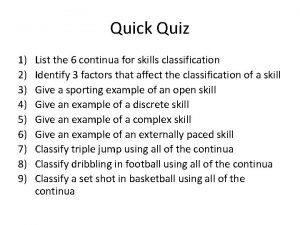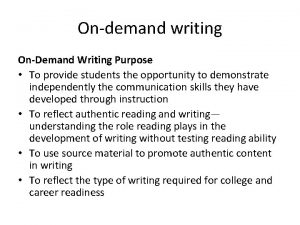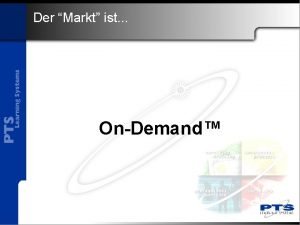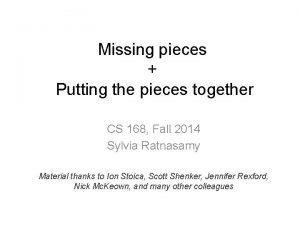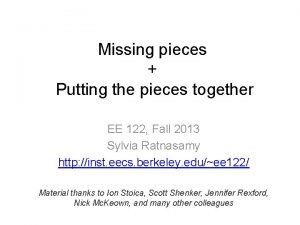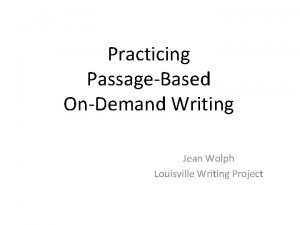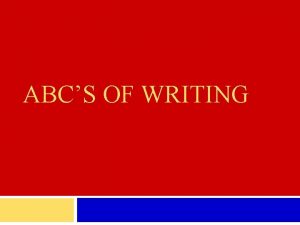OnDemand Writing The Process of Writing Whole Pieces


















- Slides: 18

On-Demand Writing The Process of Writing Whole Pieces on the CATS Test

On Demand Writing Test day n Tuesday 5/21 Schedule 8: 50 -9: 00 test instructions 9: 00 -9: 40 Part A 9: 55 -11: 25 Part B

Test Information Materials available to you: n n n Test booklet Student response booklet No. 2 Pencils Writer’s reference sheet Dictionaries Thesauri

Test information Part A = Stand alone prompt, 40 minutes, no extended time, with a choice Part B = Passage based prompt, 90 minutes, no extended time

For On-Demand Remember SPAM!

In each prompt, Situation- The event that causes you to need to write. (On the test, you have to pretend. ) Purpose- The reason you’re writing: to persuade, to narrate an event, to respond to a text/graphic/chart Audience- The person (or people) you’re pretending to write to Mode- The type of writing you are to do: letter, feature article, editorial, speech

Situation The situation is labeled for you. It’s always the first part of the prompt. It’s a make-believe situation that hasn’t really happened to you. You have to pretend. It creates a need to write.

Situation (example) Situation: Your local school board has been looking into mandatory year-round schooling for students. This would consist of a revolving schedule that has students attending school for nine weeks, then off nine weeks, with an extended summer break of five weeks. The state has decided to allow local school boards to decide whether to implement this plan. Clearly, there are pros and cons to this issue. Task: Write a letter to the Commissioner of Education about your thoughts in response to the proposal.

Purpose Look for one of these in the writing task: - Narrate an event (Share what you saw, heard, smelled, tasted, touched, or thought…. to make a point. ) - Persuade (Consider the needs/feelings of the audience as you solve problems and/or convince them. Use main ideas and supporting details. ) - Inform (Present information and provide explanation to help readers understand something. Show your ability to think through an issue and clearly explain it to others)

Audience Look in the writing task for the audience. n It might be an individual or group. You write to this pretend audience for reasons stated in the prompt. Consider what they need to know, want to know, or already know… Imagine what questions they would have for you. Answer them.

Mode: What Kind of Writing You’re to Do Look in the writing task for the mode: n n letter feature article Editorial Speech Follow the format we’ll cover for that mode

Pre-Write As soon as you get your scrap paper, write your Mode Acronyms (you’ll learn these over the next couple of weeks) n Ex. S E A for Letter

Planning your Draft State your main idea(s). Details for responding and persuading tell why and how, give examples, answer anticipated questions, etc. Details for narrating an event are sensory (see, hear, smell, taste, touch). They show, not tell about the event by including dialogue, thoughts, and actions. Rough outlines are great tools for planning your draft.

Lead Get the reader’s ATTENTION. Get the reader on the right track by indicating the focus. Put important words from the situation in your lead. Use a question, quote, comparison, command, list…. Use dialogue, action…. . Write more than one and choose your best.

Drafting the Body Follow your prewriting. n Revise as you go. n Revise when you think you’re finished. For persuading and responding, keep telling why and how. Tell stories. Give examples. Answer questions the audience might have. For narrative writing, show what happened by sharing sensory details, dialogue, thoughts, and action. Connect your ideas with transitions.

Drafting the Closing Make the piece feel finished. Give the reader something to think about, laugh at, remember. You might tie back to something you said in your title or lead. Be brief. Closings should be short.

Edit for Correctness: Check the following: Capitalization Usage (We was) Punctuation Spelling Complete Sentences Letters or Words Left Out Repitition

Final Copy Use your best handwriting. Make it LOOK like a letter, a feature article (or an editorial). Watch your margins and indent for paragraphs. Be correct and neat. If they can’t read it, they can’t score it. Don’t give up. Keep working hard. It won’t last forever.
 Cdc whole school whole community whole child
Cdc whole school whole community whole child Ondemand 5
Ondemand 5 Success plan ondemand
Success plan ondemand Call center on demand
Call center on demand Massed practice
Massed practice Hát kết hợp bộ gõ cơ thể
Hát kết hợp bộ gõ cơ thể Ng-html
Ng-html Bổ thể
Bổ thể Tỉ lệ cơ thể trẻ em
Tỉ lệ cơ thể trẻ em Gấu đi như thế nào
Gấu đi như thế nào Tư thế worm breton là gì
Tư thế worm breton là gì Chúa yêu trần thế alleluia
Chúa yêu trần thế alleluia Môn thể thao bắt đầu bằng chữ đua
Môn thể thao bắt đầu bằng chữ đua Thế nào là hệ số cao nhất
Thế nào là hệ số cao nhất Các châu lục và đại dương trên thế giới
Các châu lục và đại dương trên thế giới Công thức tính độ biến thiên đông lượng
Công thức tính độ biến thiên đông lượng Trời xanh đây là của chúng ta thể thơ
Trời xanh đây là của chúng ta thể thơ Cách giải mật thư tọa độ
Cách giải mật thư tọa độ Làm thế nào để 102-1=99
Làm thế nào để 102-1=99




